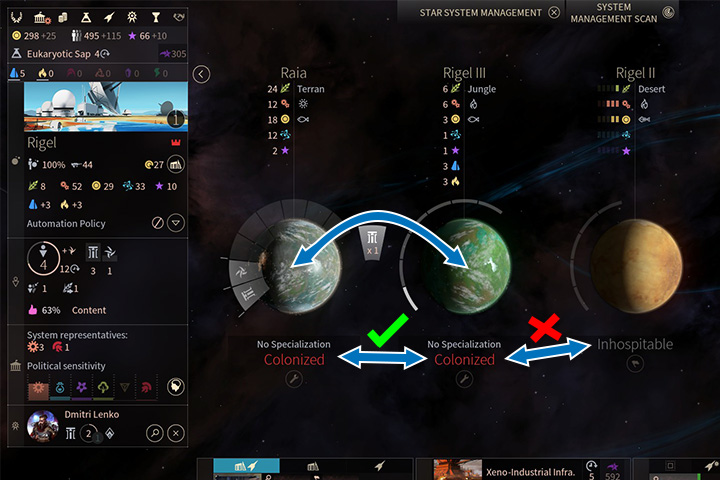Endless Space 2: Colonization, migration and evacuation

Colonizing new systems and planets is one of the most important goals in the game. Thanks to expanding your living space and territory you can increase your population and inflow of resources which in turn can increase your realm and chance to win. To obtain this goal you must use colonizing ships. Remember to select systems with very good planets or a lot of average ones. Oceanic planets or with a lot of flora are wanted by all races so it doesn't matter which faction you play as because you must choose those planets as your priority targets during the expansion. They also give Approval bonuses which is also useful. With the development of technologies you get opportunities to inhabit more planets and even reshape them into something more favorable. You can also help Ecologists in your empire. If they are in power you can colonize almost all planets although with a penalty to FIDSI productions.
In the beginning of the game you start with one ship of that type but there is nothing stopping you from building more. Especially because building colonizing ships doesn't require population unit (unlike in the previous Endless Space game)! The colonization has two steps.
First, you must find an empty system (one that is not under influence of other player) with planets that can be colonized. Such planets are marked in the game screen as white full circles (miniature planets) under a system's name. When you bring your colonizing ship to a wanted place you can click Colonize option. That ship is used in the process of constructing an outpost which is the first step to settle in that system.

The second stage is to develop your outpost. Although a given planet is under your control, its system is still neutral. If there are other planets that belongs to no one, other players can colonize them. This is where a race begins - who can develop their outpost first gets the entire system. An outpost develops on its own. It creates the first population unit by gathering a certain amount of Food that it produces by itself (1) (base production of a given planet plus production of an outpost). Civilian ships with Food, that can speed up that process (2), will start flying on this planet. They start from your capital or system that you chose. But you must remember that those ships are defenseless against pirates and fleets from enemy nations. When you select that system then under a planet's name you can see three options and a bar that shows how much time is left to get the first population unit (3). Next to it you can see an icon of a population that will appear there. Usually, it will be a population of your faction.

However, you can help your colony. You have the following options:
(1) The first is useful when in a system there is an outpost that belongs to other civilization. By using a little bit of Manpower you can take Food from other outposts.
(2) You can also fund the development of a colony and increase Food production rate by 100%.
(3) The last option is to increase system's attractiveness. By doing that more people will be encouraged to arrive in a new world.
Most of the times you are going to use the second and third option. Funding Food production is the most useful in distant worlds where ships with migrants have to travel a long way. The second is perfect for systems near your empire because thanks to that you can take over a system in a very short time. When you get your first population unit in an outpost that system becomes part of your empire and from now on you can manage it just like any other colony.
Migration and Evacuation

Migration is an easy way to use the potential of a given planet or colony in a different way. By assigning citizens to proper planets you can help in producing a particular resource or increase the Approval in a system by avoiding overpopulation. Migration can be divided into two types: interplanetary (in one system; you must have more than 1 colonized planet) or between systems. In the case of the first type all procedures are very easy. If you enter the system management option you can select population units that you want to move to a different colonized planet in the same system by moving the mouse cursor and holding LMB. Transportation process is immediate. You can do this over and over again until you are happy with the results. If the target planet is full and you want a specific type of population to inhabit it you have to do the same with population units. The game automatically assign the excess of citizens to other planet in the same system.

Migration between systems is similar although you need to have a better developed empire. In the system you must have System Development level 2. From now on you have the access to a new object in that system: a spaceport (1). System Development also gives you other profits but more about that in the dedicated chapter. Population units from planets in your system can be moved to a spaceport. Next, you select a target system and in the next turn a civilian ship is send there (2). Those ships are created automatically so you don't have to build them by yourself (3). This fleet is defenseless and exposed to enemy attacks (for example pirates) so losing it may hurt. When that fleet reaches its destination the citizens are automatically assigned to colonized planets. This is very useful if you want to quickly inhabit new systems or free some space if your systems are overpopulated.
The last option connected to inhabited systems is the Evacuation. Using this order allows you to abandon a system. You lose all buildings and population units and only get one colonizing ship. This decision can be useful if you don't want your enemies to overtake your system, a system is no longer useful to you or you want to reduce the amount of systems under your control.
- Endless Space 2 Game Guide
- Endless Space 2: Game Guide
- Endless Space 2: Gameplay basics
- Endless Space 2: FIDSI and Approval in Endless Space 2
- Endless Space 2: Manpower
- Endless Space 2: Strategic and luxury resources
- Endless Space 2: Systems and ways of travelling
- Endless Space 2: Heroes
- Endless Space 2: Exploration and Curiosities
- Endless Space 2: Colonization, migration and evacuation
- Endless Space 2: Planets and anomalies
- Endless Space 2: Population and ideologies
- Endless Space 2: Governments, elections, introducing laws
- Endless Space 2: Technologies
- Endless Space 2: Trading Companies and Marketplace
- Endless Space 2: Diplomacy
- Endless Space 2: Interface
- Endless Space 2: Gameplay basics
- Endless Space 2: Game Guide
You are not permitted to copy any image, text or info from this page. This site is not associated with and/or endorsed by the developers and the publishers. All logos and images are copyrighted by their respective owners.
Copyright © 2000 - 2025 Webedia Polska SA for gamepressure.com, unofficial game guides, walkthroughs, secrets, game tips, maps & strategies for top games.
